

| Newsletter 38 | January 2002 |
In this issue: A Dunning Artist's Mural | |
Designed to Soothe and Comfort | |
|
Other A Lost Soldier + more |
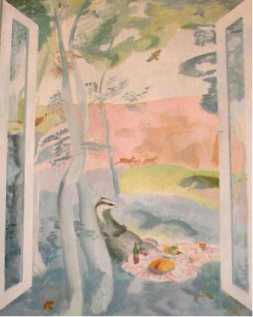
|
The More Facts We Find, The More Mysteries Pop Up
In Cathy Dewar's article about thrashing crews in our last issue, we showed you the following photo from an old album belonging to the late Jimmy Howie. His son Bill, who loaned it to us, couldn't identify most people in this or other photos. But we learned it was taken at Baldinnes farm, and now we've managed to find the identities of some of the crew.

We knew only that Jimmy Howie is second from the right. Then we found that the woman third from the right in the picture is Mrs. Nellie Duncan, who at age 89 still lives in Dunning. She kindly helped identify most of the others. The first left she thinks was a Sandy Stewart. The next woman she didn't know, but behind her is Mrs. Duncan's late husband Harry. The woman with the apron was Mrs. Hunter, whose husband worked at Baldinnes. Back a bit and fifth from the right is Mrs. Margaret Campbell, Mrs. Duncan's sister. Next is Mrs. Annie Wilson, Mrs. Nellie Duncan herself, Jimmy Howie and Sandy Wilson, husband of Annie.
Mrs. Duncan couldn't recall when the picture was taken, but the two figures in the background wearing what look like military caps, may be a clue. (One is almost hidden behind the woman in the apron.) Could this be wartime or immediate post-war, and could those be prisoners of war working on the harvest, as they did? Can any reader help answer this?
|
Husky Story After our May 2001 agm, the Society members present were unusually entertained by our DPHS secretary David Halliday. David had brought along his five Siberian huskies. First David told us the storyof how the history of man has been entwined with the history of dogs. Then he told us of the evolution of huskies in particular. Here is what David had to say: |
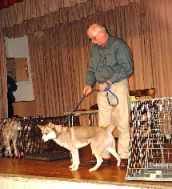
David introduces his dogs at the |
Some years ago I was on holiday in the USA with my wife Kirsty. We were on the High Plains of the Yellowstone Plateau, an area which straddles the continental divide. From here rivers flow east into the Atlantic and west into the Pacific.
These were the seemingly endless plains of Wyoming, across which the old Oregon and Mormon trails passed, the wagons etching ruts so deep that they remain visible to this day.
Town names of Cheyenne, Laramie, Cody and Casper. The Powder and Shoshone Rivers: all these names were etched on my mind from Saturday morning visits to the uproarious 'Children's Club' at my local cinema.
It was in this setting that we first came face to face with a Siberian Husky. A chance encounter, which would set us on a path that has led us to share our lives with five of these most beautiful members of the canine world.
Perhaps the first thing we should do is introduce our Siberian Huskies to you. In common with all dogs registered with the Kennel Club our dogs have a Kennel name and a pet name.
Kennel names usually contain an affix: this is a name registered by a particular breeder or owner. Our affix is ITANCA. This is a Lakota Sioux word to describe someone who takes responsibility to care for and provide for a group within his tribe.
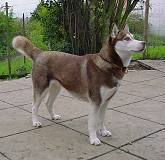
So let me firstly introduce LASINSKI'S ZAVIROOSHKA WITH ITANCA.
Or Flo. Flo is a three year old bitch. She was our first husky. Flo is very dominant and is the Alpha husky in our small pack. Her father is a show champion. Flo has a very good temperament. She is decisive, outgoing and self-confident, all qualities you would expect to find in a leader.
 Now we have ALASCOTIA MOON DANCERWITH ITANCA.
Now we have ALASCOTIA MOON DANCERWITH ITANCA.
Phoebe. She is two years old. Rates second in the hierarchy. She is the lead dog when working. Her father was imported from the USA. He is a show champion in the USA and here in the UK. Phoebe is placid, reserved and very intelligent.
 This is MATZI MIST WITH ITANCA.
This is MATZI MIST WITH ITANCA.
Angel.
Angel will be two in June. She is Flo's half-sister. They share the same sire. Angel is the most outgoing of the pack---she loves everyone. She is also very vocal.
 ALACOTIA'S SEATTLE SEA HAWK WITH ITANCA.
ALACOTIA'S SEATTLE SEA HAWK WITH ITANCA.
Known at home as Hawk but answers to the name Boy just as well. Hawk is almost 3. He was re-homed with us after being ostracised by the pack he was living with. A boisterous blue-eyed boy, he is a powerhouse when working.
 Last but far from least is Echo.
Last but far from least is Echo.
WAYRETH'S ECHO OF THE SINNER WITH ITANCA, to give her full title. Not yet two, she is the lowest ranking of them all. However, while subservient to the rest she does have her moments.
Echo runs in lead with Phoebe. A speedy young lady, she is the fastest Husky we have.
The relationship man has with the dog is arguably the closest one we have with another life form.
In the West we generally hold the dog in high esteem---although there is a growing body who see the dog as dangerous, dirty, the source of vicious and unprovoked attacks, carrying fatal and dangerous disease risk and the producer of unacceptable levels of organic pollution in streets and parks. Recent anti-dog legislation in Germany contrasts with the other Western view of the dog: as more human than animal, in which they are assumed to have the same thoughts, feelings and desires as people.
Possibly neither view is correct.

After being introduced to |
While wolves, jackals and coyotes have been studied in detail, the domestic dog has until recently been largely ignored. Granted that Darwin derived much of his Theory of Evolution from his study of the domestic dog, most biologists and behavioural scientists have seen the dog as 'unnatural', so not worthy of study, presenting the dog as a debased and corrupted wolf. Recently this has changed. It is now beginning to be regarded as a unique biological species with a fascinating and complex evolutionary history.
The Siberian Husky is one of some 400 different breeds and varieties of dog found worldwide. In Britain there are around 6.5 million dogs, ranging from the purebred dog to the appealing crossbreed. These five are pure bred, which means both their sire and dam belong to the same breed and they are themselves of unmixed descent.
The Great Exhibition of 1851 sparked a fascination in the Victorians for exhibitions. So it is not surprising that in June 1859 the first dog show was held. It took place in Newcastle-on-Tyne. Dog shows quickly spread across Britain. In 1870 a controlling body was set up which led to the first meeting of the Kennel Club taking place in 1873.
There was a growing confusion caused by the existence of a lot of dogs identified by the same name. Spots, Bobs, Jets and Nettles were common. So a 'universal registration' was introduced giving all registered dogs a unique name. To show, a dog must be registered.
The data base now comprise around 5 million registered names. In the region of 260,000 are added each year.
The dog family---Canidae-is a cohesive group of 38 species of which the domestic dog is one.
They are all terrestrial, fast running, and have their young in dens. Communication is by body posture, facial expression, tail wagging and vocalisation (howling and yelping). Although some members of the Canidae family have been bred for their fur, the dog (Canis Familaries) is the only one to have been domesticated.
There are three main theories about the origin of the domestic dog. The debate has been conducted over many years As long ago as 1758 the matter was being written about. People of the stature of Charles Darwin have been involved.
That dogs have evolved from an ancient wild species, looking like the Dingo, is the first theory, the original dog being exterminated by man.
This theory does have some credibility: if domestic dogs are allowed to go wild in feral packs they eventually revert to a similar type as seen in the Australian Dingo and the wonderfully named Singing Dog of New Guinea.
The theory favoured by Darwin was the two wild dog theory: some domestic dogs descending from the wolf and others from the jackal. This theory was popularised by Konrad Lorenz. Recent studies have shown this theory to be unfounded. The Jackal has proved very different from the Dog.
The now generally accepted theory arrived at after much detailed research points to the wolf as the principal if not only ancestor of the domestic dog.
We are accustomed to think of wolves in terms of the grey Timber Wolf. The dog is more likely to have developed from the smaller Asiatic wolf.
There is evidence that early humans and wolves had contact with each other some 400,000 years ago. Wolf skeletons and human remains show they were sharing the same territories.
The humans of that time were very limited: they could make fire and they shaped primitive stone tools, but little else. They were poor hunters and gained much of their food from scavenging.
Which group aided the other most is debatable. What we do know is that they were remarkably similar. Intelligent, adaptable opportunists. Broadly omnivorous cooperative family animals operating from a permanent base. The parents sharing responsibility of feeding, rearing and teaching their offspring. Adolescents living at home and remaining in contact when they leave. Small family units maintaining friendly ties with close relatives.
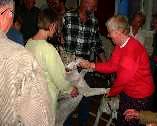
Our members at the agm |
The path of the early contact with the wolf to the domestic dog is a long one.
Domestication has been seen as slavery, subjugation of one group by another. This assumption has now been questioned. Conscious human intent is demonstrably neither necessary nor a sufficient condition for domestication. Domestication by such species as ants with aphids is seen throughout nature. The ancient Egyptians attempted to domesticate animals, which on face value were good candidates.
The dog's association with humans stretches back to a time when even on a good day men were doing very little thinking.
A standard story is that a hunter took a wolf puppy thinking it would make a good guardian and a hunter. This fits in well with the "paradigm of consciousness" (the belief that man is the author of his own history).
The problem here is that this was a wolf, not a dog.
There are few documented cases of wolves attacking humans, probably because the wolves are wary of and keep a good distance from humans.
Captive wolves, which have lost some of their fear of humans, have been seen to be unpredictable and at times dangerous. Wolves socialised with humans since birth have on occasions launched vicious attacks on people minutes after having warmly greeted them. Both captive and wolf hybrids have attacked children when the child's crying or running has triggered a predatory response, which always comes without warning.
A more likely scenario is a gradual association with humans over a long period of time. In this period some wolf populations 'adapted' to human society: scavenging around campsites, following hunters, or perhaps the hunters following them.
These wolves over time became less fearful of humans and more submissive to them. They also became isolated from the general wild wolf population, leading to change in natural selection due to their new environment. Archaeological evidence indicates that the dog was the first species to be domesticated.
Towards the end of the Ice Age (14,000 years ago) a dramatic change in hunting strategy was taking place. Up to this time a direct impact from a stone axe was used to kill animals. Now an arrow with tiny stone blades (microliths) came into common use. Dogs were of assistance in tracking animals and holding them at bay.
Remains from the period reveal a dog which has undergone morphological (shape) changes: shorter jaw, compacted teeth, and the feet had become more slender.
The upper Jordan valley has yielded up a lot of evidence of the first domestic dogs dating from some 12,000 years ago, a period when humans were on the verge of becoming agriculturists.
The domestication of the dog continued over successive generations. They became less and less like their wild forebears: coat colour, carriage of tail, shape of body and proportions of limbs all changing by a combination of natural and artificial selection. The wolf became a dog, changing from wild carnivore to part of human society.
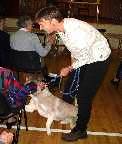
Kirsty Halliday, |
Distinctive breeds were first seen about 4000 years ago. One of the foundation breeds was a greyhound type of dog, depicted in early Egyptian paintings. By the period of the Roman Empire the main breed types were well defined. Hunting, guarding and herding dogs were all in common use.
The Middle Ages saw another proliferation in the number of dog breeds. The laws of hunting (venery) were formalised. Different breeds were used for different hunts: Deerhounds, Wolfhounds, Boarhounds to name a few.
The Industrial Revolution heralded a major change in which our civilisation was organised. Changing society made many breeds become surplus to requirements. Cruel sports such as baiting and dog fighting were banned. New roles were found. Showing dogs and the dog in the role of companion were fulfilling a need for the city dweller to have some contact with the natural world.
It was from this period in the 19th century that many of the breeds so familiar today came.
Our dogs have evolved over a long period from wolves, but they still display some 85 to 90% of wolf behaviour.
My favourite breed of dog is of course the Siberian Husky. They have a colourful history.
A tribe of people called the Chukchi inhabited the coastal region of northern Siberia. They had lived in this region of extreme winters for a thousand years. Here the people developed a dog in which today's Siberian Husky has its roots.
Living inland the Chukchi hunted primarily on the coast. Seal was their main source of food. To transport it, the Chukchi did not need a large dog to haul a great weight. What they required was a dog that could stand long exposure to low temperatures, be able to pull a moderate load quickly over great distances, expending a minimum amount of energy in the process, leaving plenty of energy to combat the weather. Dogs which were quick, small, docile and intelligent enough to work in teams. They needed to be hard, eager workers with enough sense of dedication to their task to keep from constantly tangling their sled lines. Probably the most important trait they developed was a seemingly endless wish to run.
Living in the family home they developed a gentle temperament.
The fate of the Chukchi dog and the birth of the Siberian Husky are linked to several events primarily in Russia.
In the 18th century the Chukchi survived a series of alternating policies of warfare and friendship with the Russians. The former policy was a deliberate attempt to eliminate them along with the rest of the tribes of Siberia in order to gain control of the fur trade. While the Chukchi were unable to match the Russian Cossack army in pitched battle, they were able to outrun them with the aid of their fast sled dogs. A combination of low temperatures which the horse transport of the Cossacks found difficult to deal with and a series of ambushes forced the Russian army to withdraw.
The prolonged struggle against the genocide policy of the Russians in fact strengthened the tribe; improving the quality of their dogs, which carried the people over great distances, with little food, in extremely harsh conditions during the extended guerrilla campaigns.
The members of the tribe who bred and maintained the best dogs had assumed a position of leadership and a measure of wealth. After the Revolution these people were seen as bourgeois and most were either killed or imprisoned. The Chukchi dog all but disappeared in Russia.
Chukchi dogs were taken back to Alaska by fur traders and became known as Siberian Huskies.
To relieve boredom, sled racing had been established and became a popular sport in Alaska. In 1908 a team of Siberians was entered in a race against the much larger Alaskan Huskies. After a lot of scorn was directed at them before the race they managed to finish third, attracting a lot of attention.
By 1910 a Scot by the name of Fox Ramsey owned a kennel of Siberians. He entered three teams in the race, taking first and second place.
The Siberian had arrived.
In 1925 Leonhard Seppla and his team of huskies (Echo is one of their descendants) became world famous by taking a major part in a relay of dog teams that delivered a supply of serum to a town called Nome where diphtheria had broken out: a distance of 658 miles in blizzard conditions.
The breed was recognised in America in 1930. The first Siberians arrived in Britain in 1968 and it was recognised as a registered breed in 1971.
In conclusion it is impossible not to compare the husky with the wolf. There is some evidence that wolves were used to cross breed by some Eskimo people. The Chukchi were likely to have wanted to keep the gentle friendly nature of their dogs, and are unlikely to have taken the gamble of cross breeding with wild and untrainable wolves.
--David Halliday, Newton of Pitcairns

Thanks to
Felicity Martin
and
Alf`Marshall
for taking
the digital
photos, and
to Simon
Warren for
processing.
|
Keep in touch through our Society website: www.dunning,uk.net |
Can You Help a New Member from Queensland?

James Dougall Sr. |
"I would like to apply to become a member of your Society, and enclose an order also for the book "Crossroads and Characters".
My husband and I visited Dunning in August 1999 and Ken Laing showed us around the churchyard. It was a very informative visit as my ancestors were the Dougalls from Balquhandy.
I thought you might be interested to know that John Dougall's (1838-1913) younger brothers James and Andrew established themselves on the Darling Downs in Queensland, Australia and were survived by large families. James' eldest son James was my grandfather and died in 1961 at the age of 89.
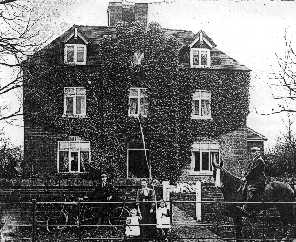 We have an old photo of a house which we always thought was the Dougalls' house at Dunning. However it is much larger than most of the houses we saw in Dunning on our visit.
We have an old photo of a house which we always thought was the Dougalls' house at Dunning. However it is much larger than most of the houses we saw in Dunning on our visit.
We wondered if anyone in your Society might know where this house is, or whether it might even have been in Perth. We went out to visit the farm at Balquhandy, and took photos of the old house there, and obviously it is not the same one!
I must thank you for your wonderful informative website. And we really appreciated the help Ken Laing gave us during our visit."
-Fiona (and Sam) Calabro,
13 St. Clair Crescent, Wishart, Queensland 4122, Australia
(Mrs. Calabro also enclosed copies of Dougall family descriptions, which we'll add to our archives).

This newsletter is published quarterly, January, April, July and October by the Dunning Parish Historical Society. |
These are the centre and right-hand panels of a mural in Auchterarder. The left-hand panel is on our cover.
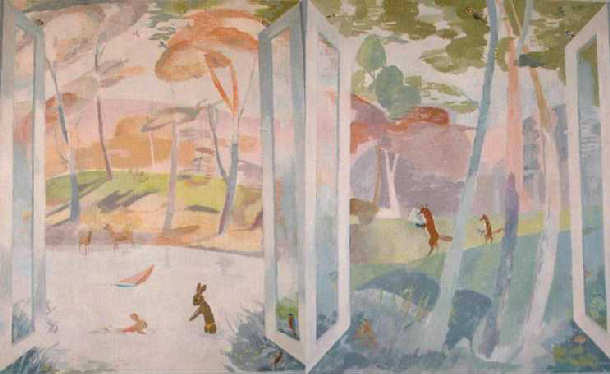
These were painted in acrylic by Mary Thomson of Dunning on a waiting room wall at St. Margaret's Hospital.
(Perspectives are slightly distorted by photography)
By Remarkable Coincidence
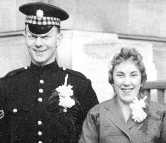
Our newsletter is always delighted to receive contributions. By remarkable coincidence, four unsolicited submissions in recent months have dealt with Dunningites and the military.
First example: At right is a proud Scots Guard photographed outside Wandsworth Barracks in 1959 with his bride. Perhaps you'll recognise David McLeish, stonemason of Dunning, and his late wife Evelyn.
Thanks to David McLeish for loaning this.

Second, from member Ronnie Taylor, Blaeberry Tollhouse:
Seeking Info on War Vets?
"From a previous issue of the DPHS newsletter where I requested information on people who lived at the Blaeberry Tollhouse, I received a phone call from a lady about her relatives the 'Fraser' family who resided there during the early 1900s. One of the sons, Andrew Y. Fraser, was killed in Flanders during WW1. The lady was unaware that I had recently listed the names from the Dunning War Memorial as part of my honorary work with The Scots at War Trust, and her relative was listed.
I have access to the Imperial War Museum records of the Soldiers who died in Word War 1, and having his details and the regiment I printed the scroll in memory of him and posted it to her. I think she was astonished!
The Scots at War Trust is a registered charity with the aim of collating information and informing the public about the history of all Scots who served their country in the armed and civilian services in the 20th century. We also have a website which other DPHS members may be interested in contacting: http://www-uksaw.arts.ed.ac.uk
--Ronnie Taylor, Blaeberry Tollhouse, Muckhart Road, Dunning PH2 0RD
personal e-mail ronnietaylor.sawt@ntlworld.com
This script came from Charlie Laing
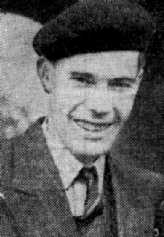
Cameron Walker in 1944 |
The Return of Private Cameron Walker
Cameron was the youngest son of Mr. and Mrs. John Walker, blacksmith, Smiddy Close, Dunning. He was born in 1918.
After leaving school he served his time as an apprentice with David Wilson, a Dunning joiner. Cameron was a grand footballer, playing first for Dunning Heather as a juvenile, then with Scone Thistle as a junior. He may well have gone far in football if the Second World War had not intervened.
On finishing his time as an apprentice, Cameron went to work on the building of the aerodrome at Scone. Whilst there he was conscripted into the Army in September 1939. After doing his training at the Barracks in Perth he was posted to the Black Watch Battalion and sent to France with the B.E.F.
When the Germans overran France, the Black Watch fought a rear guard action at St. Valery. Sometime in the middle of June 1940, the order was given "Every man for himself". Cameron, not wishing to be taken prisoner, headed inland and westward, living off the land and evading capture. When on the move he posed as an Arab from Algeria and encountered many Germans. At last he was befriended by a French farmer and his wife, and stayed with them for over four years. He lived during his enforced stay under the assumed name of Camille Valin. Whether the name of the family was Valin we do not know, but his only living sister thinks it may well have been.
1942 seems to have been an eventful year. That year he developed appendicitis, and on being taken by lorry to be x-rayed, they were stopped by the Germans. The identity cards of all his fellow passengers were examined, but not his. The operation was not very successful and he lived for four months on champagne and water. He must have been very ill at this time because the farmer and Cameron had decided where he was to be buried on the farm. That same year a son was born to the farmer and his wife and he was christened Pierre Cameron after their 'guest'. Also in 1942 someone got word to Cameron's family in Dunning that he was still alive. Once again it is not known how the information managed to get conveyed from occupied France.
When Cameron first went into hiding he could speak very little French. After working in the fields, however, he became a fluent French speaker. So much so that when he was liberated by the Canadian forces in September 1944, they could not believe he was a Scottish soldier. Repatriated to Britain, Cameron made his way home to Dunning.
When he came off the bus in the village, he was standing looking down the Smiddy Close where he had lived. He thought the place had been bombed as all the roofs had fallen in. A local girl who had been at school with him, Sheena Steven, saw him and recognised him. She went and got a family car and took him to Forteviot, two miles along the road. The family had moved there in 1941. Sheena thought that if she took him to the house it would be too much of a shock for Mrs. Walker, so she took him to the smiddy where his father and brother Andrew were working.
Cameron, although he looked not too bad, was not a well man. His years of privation had taken its toll. Because of his ill health Cameron had to report to an army hospital in Lincoln. Whether he was operated on there or not, his sister cannot remember. Anyway he was sent back to Bridge of Earn Hospital where he died on the Dec 29th, 1944.
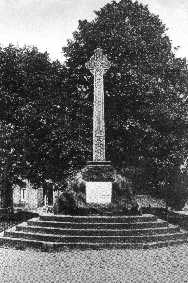
His intentions had been to return to France after the war was over, his words being "That's my country now". It also known that Cameron and his adopted family discussed emigrating to Canada when the war was over. Whether they did or not is still to be ascertained.
This is the story of a young man who suffered the horrors and hardships of war, only to die three months after being reunited with his family.
--Charlie Laing, Dunning, 2001
A fourth military submission was this 1949 postcard of the Dunning War Memorial. This was among donations to the DPHS by Don Hepburn, Ontario, from the estate of his late brother James of Dunoon.
Love Those Visitors...and our Splendid Volunteers!
One of the significant services performed for the last nine years by members of the Dunning Parish Historical Society and the Dunning Community Council has been the guiding of summer visitors to St. Serf's church and kirkyard. These session house duties as they're called (because it's at the door of the kirkgate session house that the guides await visitors) are entirely voluntary and represent great dedication by the volunteers, some of whom contribute several afternoon shifts over the season, some from the beginning of the service.
This year's volunteers have included Christine Dickson, Dorothy Wilson, Albie and Shona Sinclair, Colin and Jane Young, Nan Ross, Isobel Barnett, James Murray, Ian Lambie, Peter and Alma Duncan, Tony Keene, Alex Herd, James Smith, James Dykes, Judith Slater, Kay And David Williams, Robert Lyon, Peggy Smith, Betty Taylor, and Lorne and Patricia Wallace.
With the Dupplin Cross to be installed shortly in St. Serf's, many of us have wondered whether there'll be any session-house duties required of us in future. Our chair Raymond Young took the initiative of approaching Historic Scotland and a series of meetings is going on to decide what will be the responsibilities of Historic Scotland in regard to the expected increase in visitors, and what part the local community including your Society will play. Watch this space!
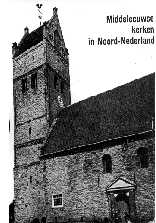
A Frisian church, |
Ideas from Our Visitors
One of the perks of being a guide at St. Serf's is that sometimes you can pick up new ideas and perceptions from knowledgeable visitors. Take this letter, for example. It's from Heather Thom of Edinburgh:

Frisian church built in |
"When we visited I mentioned the similarity of the architecture of St. Serf's to that I'd seen in visiting the northern Netherlands. Here are some photocopied pictures of the Frisian churches. They are very similar in style to St. Serf's. They are found throughout the province of Friesland, but not further south. Apparently the towers were used as a place of safety if the local village was under threat, and some have slits to shoot arrows through. There are many more in this style, but these photocopies let you see the typical ones.
There is also one in the village of Stenton in East Lothian.
What puzzles me is the distribution of the style-they are all early middle ages, but not all churches of that date are in that style."

|

|
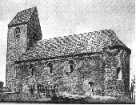
|
Nave built about 1100, | A mid-13th century | A brick Friesland |
--Heather Thom, Edinburgh
Do any of you readers have your own observations or comments to add to this?
Who Visited St. Serf's Last Year?
A report by Peter Duncan
The season 2000-2001 appears to have been a success in spite of the Foot and Mouth scares. Numbers are difficult to assess accurately but entries for the current year (September to September) cover 33 pages which is the same as last year. This equates to approximately 400 entries with a total of visitors over the 500 mark. Plus of course those who do not sign the visitors' book.
2001 has seen 105 overseas entries with Colombia, Estonia, Fiji, Hawaii, Slovakia and Tenerife added for the first time, bringing our overseas countries to 44. There were only 71 overseas entries last year.
The many comments on the informative tour and helpful volunteers show how much the efforts of all concerned with this task are appreciated.
May I thank everyone gratefully for their time at the Session House.
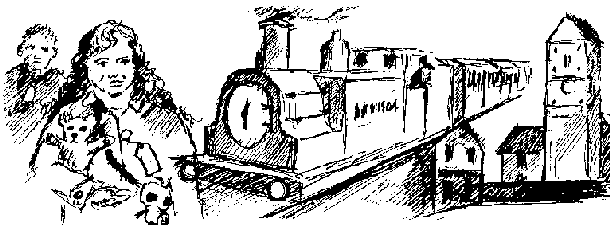
-pen and ink sketch by Albie Sinclair
After Sixty Years, Recollections on My Evacuation
to Dunning During World War II
by (Thomas) Lloyd Inglis
I was born on March 1, 1934 and at the end of August 1939 I enrolled at Parkhouse Primary School near to my home in Chestnut Street in the north of Glasgow. War was declared in September and fortunately my Dad, a railway coach body builder with the LNER, was in a reserved occupation and therefore not called up to join the armed services.
In early September my Mum, my sister Marion, who was about eighteen months old at the time, and myself were evacuated by train from Possil Station to village of Whitecross in West Lothian. We did not stay for long because my Mum was not happy with the accommodation and I did not like the school.
It was back to Glasgow and Parkhouse Primary School for a short period of time before going to Lamlash, Isle of Arran, where my Grandpa, on my mother's side, had rented a house. I was immediately enrolled at Lamlash Primary School so that my education would not be too seriously interrupted. My memories of it were of the threat of the tawse and Friday afternoons spent on the beach collecting seashells for the teacher's garden. We then returned to Glasgow and Parkhouse Primary School for some time until the Luftwaffe started bombing Glasgow and then we were uprooted again and this time off to Dunning.
My first recollection of Dunning was getting off the train, which we boarded at Buchanan Street station in Glasgow, and on to the "Wee Station Bus" to the village. The bus had utility seats i.e. slats of wood. The driver started the bus with a starting handle at the front and I thought that he was winding it up like my toy motorcar, but at least it saved the walk from the station.
I do not remember much about the ground floor flat in the Commercial Buildings, which we shared with my Aunt Nessie and my cousin Nita Inglis other than it appeared to be rather dark and dingy. A gaslight, which comprised a rather fragile mantle and glass globe fitting provided the artificial light which was so poor that Mum did all her knitting, sewing and darning at the window in the daylight. In the kitchen there was an old fashioned range with an oven, used mainly to dry twigs and pine cones to provide kindling for the fire. The flues had to be cleaned regularly and the grate black-leaded, a very dirty job and one which my Mum did not enjoy. There was no running hot water and any hot water required had to be obtained from the large kettles sitting on the range. This was very different from our home in Glasgow where we had electric light, power and running hot water.
Monday was wash day and Mum had to go to the washhouse at the back and light a fire under the copper bin. This heated the water for the washing, which was boiled and stirred with a wooden podger. On wet days the washing was dried on a pulley in the kitchen and ironed with heavy black irons heated on the cooking plates on the range.
My memories of Dunning Public School are of a large room with a stove at the front and a class of different ages doing different things at the same time. I suppose that in modern parlance it was a "composite" class but not being local or from Haghill School I felt a bit of an outsider. The school day started with the hymn "All things bright and beautiful" and ended with the sun streaming through the west facing windows and the hymn "Now the day is over". This signalled the end of my daily incarceration -- my perception of school. I can still remember having to learn the words of hymns and psalms with the constant threat of the tawse should I be less than perfect. Although to this day I can still recite the words I have often wondered the purpose of this rote learning. On July 15, 1943 The Hon Cecily Rollo presented me with a bible for Religious Knowledge. If my memory serves me correctly a Lilly Freeland won the prize for academic excellence. The school children were encouraged to help the war effort by picking rose hips and collecting the strands of wool left by the sheep on bushes and barbed wire fences. The school records show that I enrolled in Dunning Public School on August 18, 1941, and left on August 30, 1943.
As my Dad, who remained in Glasgow, worked a five and a half-day week came to Dunning on a Saturday afternoon and working for the railways he was entitled to a "privilege ticket" which reduced the cost considerably. Often he had to work on a Sunday and therefore had to return to Glasgow by train on the Saturday night. If he stayed for an extra day he had to travel home by bus as the trains did not stop at Dunning on a Sunday. One Saturday we were expecting him to arrive but he did not come due to a very heavy snowfall. Not only were the railway lines blocked but also deep snowdrifts between the station and the station woods blocked the road to the railway station. At that time men cleared the drifts with shovels and horse drawn ploughs one of which became buried in the snow and the horse perished.

Lloyd and |
A Mrs Bowie had an allotment on a piece of ground below the school and on the opposite side of the Dragon Road from the public park where we sledged in the winter. During our summer holidays we picked raspberries, strawberries, red currants, black currants and gooseberries. Mum used them to make jam and jelly and both my sister and myself helped to clean the raspberries and strawberries and top and tail the blackcurrants. Mrs Bowie also had a number of beehives and for a special treat Mum would buy a section of comb honey. I was fascinated by Mrs Bowie's explanation of how a hive worked and how the honey was gathered. After that I wanted to keep bees but that was not possible in a city. Twenty years later when my wife, myself and our two children moved from Bishopbriggs in the suburbs of Glasgow to Fintry, West Stirlingshire I purchased two WBC hives and kept them at the bottom of our garden for the next thirty years.
At harvest time helping in the fields on the farm along the Auchterarder road was another exciting activity. The reaper cut the corn (oats); the binder followed and bound it into sheaves, which were then stooked. Clydesdale horses drew both the reaper and binder and a man with a scythe went round cutting any corn that the reaper had missed at the outside edges and we followed behind helping to gather it up. I can remember the anguish if there was a lot of rain before the stooks were gathered in and built into stacks. The arrival of the thresher with its huge steam traction engine was a time of great activity. When coming near to the bottom of the stack all the workers would stand round with the dogs and pitchforks ready to kill the rats as they scurried out from the bottom of the stack. In October we howked tatties on the farm on Station Road and my memories are of cold, frosty, damp, driech days working in the glaur; but we were assured that it was all part of our contribution to the war effort!
One summer beech trees were cut down in the field behind the house. My Mum said that the field was part of the Duncrub Estate and belonged to Lord Rollo, the Baron of Dunning. The woodsmen cut round the base of the tree with large axes before using very large two-handed saws to fell the trees. Sometimes when a tree came down the red squirrels, which were nesting in it, were scattered over the ground.
After the woodsmen had finished for the day we collected the large wood chips in a wicker basket to take home. It was great fun watching the trees being felled, the woodsmen sharpening their saws and eating their pieces (sandwiches). The water for their tea was boiled in a billycan on a log fire.
Behind the village hall there was an army camp where soldiers were billeted for what seemed to be short spells. They arrived at the camp in large convoys of trucks in the late evening and when they were leaving they left during the night. Among the many nationalities there were a number of Canadian soldiers from Ontario and I can remember one of them giving me a jar of maple syrup to put on my porridge. Mum was horrified as it was only the cream from the top of the milk bottle and a little salt that was allowed on porridge made with pinhead oatmeal. I was in Canada in 1989 and after nearly fifty years I again tasted maple syrup. Alas it tasted far too sweet.
The village hall, which was on the opposite side of the road from our house used to have picture shows and concerts at which my Aunt Nessie often played the piano and sang. The Women's Temperance movement held meetings, which my Mum, a Rechabite, attended. On one occasion after the soldiers left we wandered round the empty army camp and I can recall finding and bringing home an empty Indian Pale Ale bottle. Mum seemed upset and gave me a lecture on the evils of strong drink, which, at that time, meant absolutely nothing to me. After that for me at least the camp was out of bounds.
I have no recollection of being unwell while in Dunning but had my tonsils and adenoids removed in Bridge of Earn hospital in the summer of 1943. The ward was full of men from the RAF and I was spoiled.
I have often reflected on the influence my evacuation to Dunning has had on my life. It gave me an appreciation of a rural environment and the value of space while growing up. I learned about the role of nature and how dependent we are on those who work on the land.
I returned to Glasgow and Parkhouse Primary School, sat my qualifying examination and progressed to Possil Senior Secondary School. During my third year I had the opportunity to complete my fourth, fifth and sixth years at Queen's Park SS School and Lawmuir Agricultural College. This I jumped at and ended my school career with five "Highers" including agriculture and botany, both of which drew on my experiences and knowledge gained in Dunning.
I wanted my career to move forward in agriculture but as there was no family background in farming and insufficient money for me to purchase a farm it would have meant working as a farm manager and that had no appeal for me. I trained and qualified as a chartered quantity surveyor and have worked overseas and wherever I have been I have always taken an interest in the agriculture of the area.
I believed having spent a number of my formative years in the country with space about me that my children should also experience the same sense of space and freedom and thus the move to Fintry in January 1966.
-Thomas Lloyd Inglis
 Ink sketch by |
Report on Events
Handloom weaving, such an important strand in the history of Dunning, was scheduled as our December topic, with a talk by Colin Mayell of Crieff, who has written a book on the subject. Our deadline means we'll report on this meeting in our next issue.
We can report that the autumn meetings were a great success. On October 11, we saw the wildlife video handiwork of David Doig and Brian Boag, and formally launched our 2002 Historic Wildife Calendar with wonderful sketches by Henry Hoey. (Copies still available for just £3 from local shops or the DPHS office: a great bargain!)
And on November 3, our "Just Bring a Smile" coffee morning brought many visitors, the theme being an invitation to come and see the Society's new digital camera. Many smiling people posed happily for portraits for our historical records (in this year of the census), and we were able to print and display a number of the pictures during the event. A great time!

|
The DPHS 2002 |

|
- Thursday, January 17/02. 7 pm "Burns Night" Village Hall. Another fine evening of food and fun. Book at Dunning P.O. Very few tickets left.
- Thursday, Feb.14/02 7:30 pm Village Hall. Colin Williamson reports on how the Dupplin Cross came (yes, it is coming!) to Dunning.
- Thursday, March 14/02 7:30 pm Village Hall. "Fantastic St. Pancras". Calum Rollo, Keltie Castle, Dunning, tells of his work as archaeologist at famous St. Pancras Station in London.
- Thursday, April 11/02 7:30 pm "Members Night" Village Hall. Raymond and Jean Young describe their Japanese tour.
- Friday-Sunday, April 19-21/02 "Historical Rally" An unusual getaway planned for DPHS members in a Cairngorms hotel-call Jean Young 01764 684 640 for cost, details and booking. Already nearly 3/4 full, call soon.
- Thursday, May 9/02 Our agm, followed by an historic "Revival of Dunning's Merrymakers"...a well-known local troupe.

Further details about events in our January newsletter. Make sure you don't forget |
|
Next Issue: plus much more |
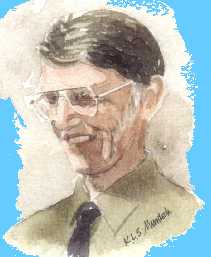
Portrait of Alan McFarlane, |